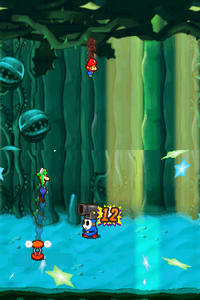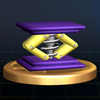Trampoline: Difference between revisions
No edit summary |
No edit summary |
||
| Line 12: | Line 12: | ||
'''Springboards''', or '''Springs''', are items that appear in the ''[[Donkey Kong (game)|Donkey Kong]]'' series and the [[Mario (series)|''Mario'' series]]. In their initial appearance, springs are harmful to [[Mario]], but they can later also be helpful. | '''Springboards''', or '''Springs''', are items that appear in the ''[[Donkey Kong (game)|Donkey Kong]]'' series and the [[Mario (series)|''Mario'' series]]. In their initial appearance, springs are harmful to [[Mario]], but they can later also be helpful. | ||
In the ''[[Donkey Kong (game)|Donkey Kong]]'' arcade game, [[Donkey Kong]] would throw springs at Mario in the level [[75m]]. If Mario gets hit by a spring, he loses a life. In ''[[Donkey Kong (Game Boy)|Donkey Kong]]'' for the [[Game Boy]], the original harmful springs return, but several others also make an appearance. Stationary Springs are found throughout levels. If Mario jumps on one, he can jump higher than usual. | In the ''[[Donkey Kong (game)|Donkey Kong]]'' arcade game, [[Donkey Kong]] would throw springs at Mario in the level [[75m]]. If Mario gets hit by a spring, he loses a life. In ''[[Donkey Kong (Game Boy)|Donkey Kong]]'' for the [[Game Boy]], the original harmful springs return, but several others also make an appearance. Stationary Springs are found throughout levels. If Mario jumps on one, he can jump higher than usual. | ||
| Line 49: | Line 48: | ||
==Gallery== | ==Gallery== | ||
<gallery> | <gallery> | ||
File:Spring.png|''Donkey Kong'' | |||
File:SMB Tram.png|''Super Mario Bros.'' | File:SMB Tram.png|''Super Mario Bros.'' | ||
File:SMW Tram.png|''Super Mario World'' | File:SMW Tram.png|''Super Mario World'' | ||
Revision as of 22:11, June 6, 2012
- “I found a springboard for you! Ground-pound it to bounce high!”
- —Luma, Super Mario Galaxy 2
Template:Item-infobox Springboards, or Springs, are items that appear in the Donkey Kong series and the Mario series. In their initial appearance, springs are harmful to Mario, but they can later also be helpful.
In the Donkey Kong arcade game, Donkey Kong would throw springs at Mario in the level 75m. If Mario gets hit by a spring, he loses a life. In Donkey Kong for the Game Boy, the original harmful springs return, but several others also make an appearance. Stationary Springs are found throughout levels. If Mario jumps on one, he can jump higher than usual.
Springboards can also be placed in the Game Boy game. When Mario jumps at a Spring block, the game freezes and the player has to place the Spring to any free point in the level. The Spring is timed, and disappears after the time has passed. This timer indicated with a music that starts playing as soon as the road is placed and gets faster gradually. The timer can be reset to 0 if Mario places another Spring within the first Spring's time limit, or any other placeable objects such as Roads, Ladders, and blocks. After disappearing, the Spring can then be placed with the Spring block again.
In the Mario vs. Donkey Kong series, springs are common obstacles. In Mario vs. Donkey Kong, they appear in many levels, including some boss battles, where they are often needed to clear levels. They are placed on the ground or sometimes in mid-air. Springs also make an appearance in Mario vs. Donkey Kong 2: March of the Minis, Mario vs. Donkey Kong: Minis March Again!, and Mario vs. Donkey Kong: Mini-Land Mayhem!, where they are needed to guide the Mini Marios throughout many stages. In these games, the springs can either bounce the minis straight into the air, or bounce them to the left or right. In Mario vs. Donkey Kong: Mini-Land Mayhem!, these springs are named Vertical Springs and Horizontal Springs.
In Super Smash Bros. Brawl, like a few other items (Peanut, Peach, etc.), the Spring does not appear regularly like a typical item, but appears after a certain attack - in this case, Sonic's Spring Jump. If Sonic does this in mid-air, the spring simply falls to the stage, damaging anyone unlucky enough to have it dropped on them. However, if he performs it on the ground, the spring temporarily sticks where it is, allowing other players to use it. It will disappear after approximately six seconds.
There is also another Spring in the game, which is modeled after the Mario series. Unlike Sonic's Spring, this Spring is a normal item that appears in the game regularly. If jumped on, a player will be launched in the air extra high than with a normal jump. If the Spring is knocked on its side, however, the player will be launched sideways.
In Super Mario Galaxy and Super Mario Galaxy 2, there are two types of Springboards: blue Springboards can be used by simply jumping on them, and orange Springboards can bounce Mario extra high if he Ground Pounds on them.
Trampoline
Trampolines are objects with various uses in the Mario series. Trampolines have appeared in many other Mario games. Their first appearance was in Super Mario Bros. They were used to jump to higher places in the game. With the right timing of pressing the button, the player will have Mario (or Luigi) be able to go high in the air. They have also appeared in Super Mario World (where they were called Jumping Boards), New Super Mario Bros., Paper Mario series, and many other games. In Paper Mario a Jack-in-the-Box acted as a trampoline.
In Super Mario Bros.: The Lost Levels, there was a green type of trampoline that allowed Mario to stay in the air for a while.

A Trampoline plays an important role in the Club Nintendo comic "Mario will hoch hinaus." Trying to impress Princess Peach, Mario uses one which pushes him extremely high. Even several hours later he is still not coming down.
In Super Mario Sunshine, Trampolines appeared in Noki Bay. When water touches them, they shrink and Mario is able to carry them around, allowing him to reach different high places.
In Mario & Luigi: Partners in Time, they are very powerful Bros. Items that require the availability of all four Bros. in order to be used. Each Bro. jumps onto the trampoline, then bounces high up, farther than even the top screen. Then the Bros. come down in random order and stomp on the foe, and if timed correctly, jump back onto the trampoline for a second (third, fourth etc.) jump. If the timing is missed, he will knock the trampoline away, ending the assault after the other three have fallen.
In Super Mario 64 DS and New Super Mario Bros., there are two minigames that use trampolines, Trampoline Time and Trampoline Terror. To play them, the player must draw lines with the Stylus to make trampolines for three Marios to bounce on.
In Super Mario Galaxy and Super Mario Galaxy 2, the trampolines here are known as Springboards, the same name as the ones from the Donkey Kong games. There are two types of Springboards: blue Springboards can be used by simply jumping on them, and orange Springboards can bounce Mario extra high if he Ground Pounds on them.
Gallery
- Spring.png
Donkey Kong
- SMB Tram.png
Super Mario Bros.
- SMW Tram.png
Super Mario World
- PiT Trampoline sprite.PNG
Mario and Luigi: Partners in Time
Super Smash Bros. Brawl Trophy Information
Trivia
- In Super Smash Bros. Brawl, if a player bounces on a spring, the sound effect from Donkey Kong Jr. from the spring that appears on the second level, can be heard.
| Super Smash Bros. | ||||
|---|---|---|---|---|
| Playable characters | Donkey Kong • Fox • Kirby • Link • Luigi • Mario • Yoshi • Others | |||
| Non-playable characters | Bob-omb • Whispy Woods | |||
| Bosses | Giant Donkey Kong • Metal Mario | |||
| Stages | Peach's Castle • Yoshi's Island • Congo Jungle • Hyrule Castle • Mushroom Kingdom • Others | |||
| Items | Barrel • Bob-omb • Crate • Egg • Fire Flower • Green Shell • Hammer • Red Shell • Star • Star Rod • Target | |||
| Moves | Miscellaneous | Jump • Taunt | ||
| Special | Standard | Up | Down | |
| Mario | Fireball | Super Jump Punch | Mario Tornado | |
| Luigi | Green Fireball | Luigi Cyclone | ||
| Donkey Kong | Giant Punch | Spinning Kong | Hand Slap | |
| Yoshi | Egg Lay | Egg Throw | Yoshi Bomb | |
| Other | Gallery • Glitches • Pre-release and unused content • Quotes • Staff | |||





